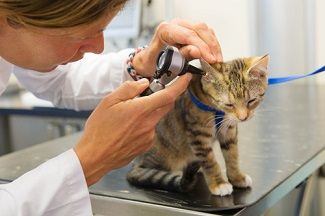Assessing Pain in Cats
To treat your painful patients effectively, you must know how to assess their pain level—a determination that can be particularly difficult in cats.

There is no gold standard for assessing pain in cats, although various types of pain scales can help. In a UK study, 80% of veterinary nurses agreed that pain scales are useful in assessing the degree of pain their patients are feeling.
Because the clinical signs and response to pain-relieving medications can vary widely among cats, it is important to assess pain both visually and by palpation.
The following pain scoring system is provided by the International Veterinary Academy of Pain Management.
[Looking for how to assess pain in dogs? Click here.]
Pain Score: 0
- Psychological and Behavioral Signs: The cat is content and quiet when unattended, comfortable when resting, and interested in or curious about its surroundings.
- Response to Palpation: The cat is not bothered by palpation of the wound, surgery site, or anywhere else.
- Body Tension: Minimal
Pain Score: 1
- Psychological and Behavioral Signs: The signs of pain are often subtle and not easily detected in the hospital setting, but are more likely to be detected by the owner at home. At home, the earliest signs of pain in a cat may be withdrawal from its surroundings or a change in its normal routine. At the hospital, the cat may be content or slightly unsettled. The cat may also be less interested in its surroundings but will look around to see what is going on.
- Response to Palpation: The cat may or may not react to palpation of the wound or surgery site.
- Body Tension: Mild
Pain Score: 2
- Psychological and Behavioral Signs: The cat shows decreased responsiveness, a decreased appetite, seeks solitude, and lies curled up or tucked up. The cat is quiet and there’s a loss of brightness in its eyes, which may be partially or mostly closed. The hair coat appears very rough or fluffed up. The cat may also intensively groom a painful or irritating area.
- Response to Palpation: The cat responds aggressively or tries to escape if the painful area is palpated or approached. The cat will tolerate attention, though, and may even perk up when petted as long as the painful area is left alone.
- Body Tension: Mild to moderate
- Next Steps: Reassess analgesic plan
Pain Score: 3
- Psychological and Behavioral Signs: The cat yowls, growls, or hisses continuously when unattended. The cat may also bite or chew at the wound but is unlikely to move if left alone.
- Response to Palpation: The cat growls or hisses at nonpainful palpation, which may mean the cat is experiencing allodynia or wind-up pain or may fear worsening pain. The cat reacts aggressively to palpation and adamantly pulls away to avoid any contact.
- Body Tension: Moderate
- Next Steps: Reassess analgesic plan
Pain Score: 4
- Psychological and Behavioral Signs: The cat is prostrate and potentially unresponsive to or unaware of its surroundings. It’s very difficult to distract the cat from pain. Even so, the cat is receptive to care, even if it is wild or mean.
- Response to Palpation: The cat may not be responsive to palpation and may be rigid to avoid painful movement.
- Body Tension: Moderate to severe
- Next Steps: Reassess analgesic plan
Podcast CE: A Surgeon’s Perspective on Current Trends for the Management of Osteoarthritis, Part 1
May 17th 2024David L. Dycus, DVM, MS, CCRP, DACVS joins Adam Christman, DVM, MBA, to discuss a proactive approach to the diagnosis of osteoarthritis and the best tools for general practice.
Listen